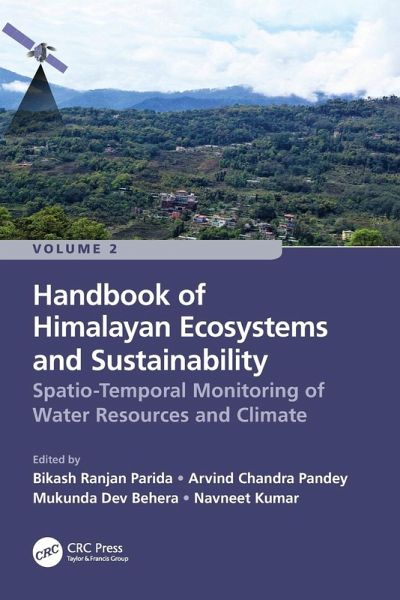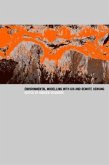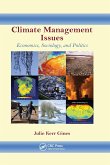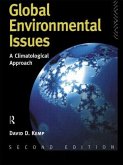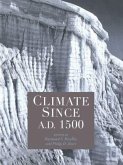Handbook of Himalayan Ecosystems and Sustainability, Volume 2
Spatio-Temporal Monitoring of Water Resources and Climate
Herausgeber: Pandey, Arvind Chandra; Kumar, Navneet; Behera, Mukunda Dev; Parida, Bikash Ranjan
Handbook of Himalayan Ecosystems and Sustainability, Volume 2
Spatio-Temporal Monitoring of Water Resources and Climate
Herausgeber: Pandey, Arvind Chandra; Kumar, Navneet; Behera, Mukunda Dev; Parida, Bikash Ranjan
- Broschiertes Buch
- Merkliste
- Auf die Merkliste
- Bewerten Bewerten
- Teilen
- Produkt teilen
- Produkterinnerung
- Produkterinnerung
With advanced remote sensing and GIS tools, in-depth analyses, and interdisciplinary approaches, this volume studies glacier dynamics and snow cover variabilities, river basins, their hydrology, ecology, and flooding. Discusses also urban ecosystem, particulates and their deposition in the Himalayas, and the impact of climate change.
Andere Kunden interessierten sich auch für
![Environmental Modelling with GIS and Remote Sensing Environmental Modelling with GIS and Remote Sensing]() Andrew Skidmore (ed.)Environmental Modelling with GIS and Remote Sensing115,99 €
Andrew Skidmore (ed.)Environmental Modelling with GIS and Remote Sensing115,99 €![Volume 1: Seabird Biodiversity and Human Activities Volume 1: Seabird Biodiversity and Human Activities]() Volume 1: Seabird Biodiversity and Human Activities89,99 €
Volume 1: Seabird Biodiversity and Human Activities89,99 €![Human Ecology and Climatic Change Human Ecology and Climatic Change]() Human Ecology and Climatic Change34,99 €
Human Ecology and Climatic Change34,99 €![Climate Management Issues Climate Management Issues]() Julie K GinesClimate Management Issues91,99 €
Julie K GinesClimate Management Issues91,99 €![Global Environmental Issues Global Environmental Issues]() David KempGlobal Environmental Issues110,99 €
David KempGlobal Environmental Issues110,99 €![The Mantle and Core The Mantle and Core]() R.W. Carlson (ed.)The Mantle and Core129,99 €
R.W. Carlson (ed.)The Mantle and Core129,99 €![Climate Since AD 1500 Climate Since AD 1500]() JonesClimate Since AD 1500153,99 €
JonesClimate Since AD 1500153,99 €-
-
-
With advanced remote sensing and GIS tools, in-depth analyses, and interdisciplinary approaches, this volume studies glacier dynamics and snow cover variabilities, river basins, their hydrology, ecology, and flooding. Discusses also urban ecosystem, particulates and their deposition in the Himalayas, and the impact of climate change.
Hinweis: Dieser Artikel kann nur an eine deutsche Lieferadresse ausgeliefert werden.
Hinweis: Dieser Artikel kann nur an eine deutsche Lieferadresse ausgeliefert werden.
Produktdetails
- Produktdetails
- Verlag: Taylor & Francis Ltd
- Seitenzahl: 380
- Erscheinungstermin: 13. März 2025
- Englisch
- Abmessung: 234mm x 156mm
- Gewicht: 453g
- ISBN-13: 9781032207735
- ISBN-10: 1032207736
- Artikelnr.: 73143269
- Herstellerkennzeichnung
- Libri GmbH
- Europaallee 1
- 36244 Bad Hersfeld
- gpsr@libri.de
- Verlag: Taylor & Francis Ltd
- Seitenzahl: 380
- Erscheinungstermin: 13. März 2025
- Englisch
- Abmessung: 234mm x 156mm
- Gewicht: 453g
- ISBN-13: 9781032207735
- ISBN-10: 1032207736
- Artikelnr.: 73143269
- Herstellerkennzeichnung
- Libri GmbH
- Europaallee 1
- 36244 Bad Hersfeld
- gpsr@libri.de
Bikash Ranjan Parida is an assistant professor at Central University of Jharkhand (CUJ), India since September 2016. He received his M.Sc. in Geoinformatics (2006) from the University of Twente and his PhD from the University of Hamburg/ Max Planck Institute for Meteorology (2011). Prior to joining CUJ, he was employed by various premium institutes involved in Earth and Environmental studies He has contributed to several national research projects such as Science and Engineering Research Board (SERB) under the Department of Science and Technology (DST), Start-Up Research Grant by UGC, NISAR project by SAC, Ahmedabad, ISRO. He has more than 40 research publications in peer-reviewed journals. A.C. Pandey is a professor in the Department of Geoinformatics at Central University of Jharkhand (CUJ), India. He is the former Head of the Department of Geoinformatics (2013-2020) and the former Dean of the School of Natural Resource Management (2013-2016) at CUJ. He has been the CUJ Coordinator for ISRO and EDUSAT program since 2013. From 2004-2013 he was an associate professor of Remote Sensing in Birla Institute of Technology. He received his Ph.D. degree in Geology from Department of Geology at the University of Delhi in 2001. He has published more than 70 articles and two edited books. He is the recipient of NASA-SERVIR Fellowship in 2013 to work on Himalayan glaciers in Zanskar Valley, J&K. Mukunda Dev Behera has made outstanding contributions to the fields of forest remote sensing and ecological climatology. His research innovations have fundamentally transformed the study of phytogeography, with attention to ecological functioning of three ecosystem components, plant diversity-water-energy. Dr. Behera has been a Guest Editor for six special issues and has served in three editorial boards of Springer's journals: Biodiversity and Conservation, Environmental Monitoring and Assessment, and Tropical Ecology. With over 20-year research and teaching experience, he has published over 100 articles. Navneet Kumar is a senior researcher at the Center for Development Research (ZEF), University of Bonn in Germany. He received his PhD in Engineering from the University of Bonn. His main research fields are water and natural resources management and Geoinformatics. Dr. Kumar has contributed to several projects in Algeria, Ethiopia, India, Mali, Niger and Uzbekistan. These projects include research on the impact assessment of climate change and land use change. He has presented his work in several international conferences and has published with several journals.
Introduction to Himalaya. Section 1: Geospatial Approaches for Monitoring
Cryosphere and Hydro- Climatic Disasters. Monitoring Spatio-Temporal
Glacier Dynamics and Snow Cover Variability Focused on Runoff Variability
Among Major Glaciers in Zanskar Valley, Ladakh, India. Glacier Velocity
Estimation Over Select Large Glaciers in Himalaya. Monitoring
Spatio-Temporal Patterns of Glacial Lakes in Sikkim Himalayas Using
Satellite Data and Nonparametric Statistical Testing Techniques. Monitoring
Flooding Inundation Using SAR Data: A Case Study on Brahamputra River
Basin. Modelling Floodwater Depth Using GIS-Based Spatial Statistical
Technique: A Case Study on Gandak River Basin. Identification of Flood
Hotspot Zone Using GIS-Based Spatial Statistical Technique: A Case Study on
Kosi River Basin. Section 2. Geospatial Approaches for Monitoring Water
Resources and Climate Change. Climate Change Impact on Hydrological
Extremes of Himalayan River Basin in Hindu-Kush Himalayan Region. Climate
Change Projections Using CMIP6 Gcms in Himalayan River Basin: A Case Study
in Koshi River Basin, Nepal. Impact of Structural Barriers on the
Morphology and Ecology of the Himalayan Rivers. Modeling the Potential
Impact of Land Use and Land Cover Change on the Hydrology of Himalayan
River Basin: A Case Study of Manipur River, India. The Application of
Remote Sensing for Water Resources Management in Data-Scarce Watersheds in
the Hindukush-Himalaya Region: A Case of Kabul River Basin. Management
Issues of Wetlands in Himalayan Foothills: A Case Study of Baigul Wetland.
Section 3: Geospatial Approaches for Monitoring Urban Ecosystem. Urban
Sprawl and Future Growth Projection Vis A Vis Groundwater Resource
Availability in Hill Township of Shillong, India. Effect of Lockdown on
Aerosol Optical Depth and NO2 Over Major Cities of Indian Himalayan Region.
Study on Spatial Distribution, Temporal Variation and Growth Trends of
Particulate Matter, Sulfur Dioxide, Nitrogen Oxides and Ammonia from
Anthropogenic Sources Over India. Spatial Distribution of Particulate
Organic Carbon Over India and Prediction of its Deposition in the Himalayas
Through GIS-WRF-Camx Modeling System.
Cryosphere and Hydro- Climatic Disasters. Monitoring Spatio-Temporal
Glacier Dynamics and Snow Cover Variability Focused on Runoff Variability
Among Major Glaciers in Zanskar Valley, Ladakh, India. Glacier Velocity
Estimation Over Select Large Glaciers in Himalaya. Monitoring
Spatio-Temporal Patterns of Glacial Lakes in Sikkim Himalayas Using
Satellite Data and Nonparametric Statistical Testing Techniques. Monitoring
Flooding Inundation Using SAR Data: A Case Study on Brahamputra River
Basin. Modelling Floodwater Depth Using GIS-Based Spatial Statistical
Technique: A Case Study on Gandak River Basin. Identification of Flood
Hotspot Zone Using GIS-Based Spatial Statistical Technique: A Case Study on
Kosi River Basin. Section 2. Geospatial Approaches for Monitoring Water
Resources and Climate Change. Climate Change Impact on Hydrological
Extremes of Himalayan River Basin in Hindu-Kush Himalayan Region. Climate
Change Projections Using CMIP6 Gcms in Himalayan River Basin: A Case Study
in Koshi River Basin, Nepal. Impact of Structural Barriers on the
Morphology and Ecology of the Himalayan Rivers. Modeling the Potential
Impact of Land Use and Land Cover Change on the Hydrology of Himalayan
River Basin: A Case Study of Manipur River, India. The Application of
Remote Sensing for Water Resources Management in Data-Scarce Watersheds in
the Hindukush-Himalaya Region: A Case of Kabul River Basin. Management
Issues of Wetlands in Himalayan Foothills: A Case Study of Baigul Wetland.
Section 3: Geospatial Approaches for Monitoring Urban Ecosystem. Urban
Sprawl and Future Growth Projection Vis A Vis Groundwater Resource
Availability in Hill Township of Shillong, India. Effect of Lockdown on
Aerosol Optical Depth and NO2 Over Major Cities of Indian Himalayan Region.
Study on Spatial Distribution, Temporal Variation and Growth Trends of
Particulate Matter, Sulfur Dioxide, Nitrogen Oxides and Ammonia from
Anthropogenic Sources Over India. Spatial Distribution of Particulate
Organic Carbon Over India and Prediction of its Deposition in the Himalayas
Through GIS-WRF-Camx Modeling System.
Introduction to Himalaya. Section 1: Geospatial Approaches for Monitoring
Cryosphere and Hydro- Climatic Disasters. Monitoring Spatio-Temporal
Glacier Dynamics and Snow Cover Variability Focused on Runoff Variability
Among Major Glaciers in Zanskar Valley, Ladakh, India. Glacier Velocity
Estimation Over Select Large Glaciers in Himalaya. Monitoring
Spatio-Temporal Patterns of Glacial Lakes in Sikkim Himalayas Using
Satellite Data and Nonparametric Statistical Testing Techniques. Monitoring
Flooding Inundation Using SAR Data: A Case Study on Brahamputra River
Basin. Modelling Floodwater Depth Using GIS-Based Spatial Statistical
Technique: A Case Study on Gandak River Basin. Identification of Flood
Hotspot Zone Using GIS-Based Spatial Statistical Technique: A Case Study on
Kosi River Basin. Section 2. Geospatial Approaches for Monitoring Water
Resources and Climate Change. Climate Change Impact on Hydrological
Extremes of Himalayan River Basin in Hindu-Kush Himalayan Region. Climate
Change Projections Using CMIP6 Gcms in Himalayan River Basin: A Case Study
in Koshi River Basin, Nepal. Impact of Structural Barriers on the
Morphology and Ecology of the Himalayan Rivers. Modeling the Potential
Impact of Land Use and Land Cover Change on the Hydrology of Himalayan
River Basin: A Case Study of Manipur River, India. The Application of
Remote Sensing for Water Resources Management in Data-Scarce Watersheds in
the Hindukush-Himalaya Region: A Case of Kabul River Basin. Management
Issues of Wetlands in Himalayan Foothills: A Case Study of Baigul Wetland.
Section 3: Geospatial Approaches for Monitoring Urban Ecosystem. Urban
Sprawl and Future Growth Projection Vis A Vis Groundwater Resource
Availability in Hill Township of Shillong, India. Effect of Lockdown on
Aerosol Optical Depth and NO2 Over Major Cities of Indian Himalayan Region.
Study on Spatial Distribution, Temporal Variation and Growth Trends of
Particulate Matter, Sulfur Dioxide, Nitrogen Oxides and Ammonia from
Anthropogenic Sources Over India. Spatial Distribution of Particulate
Organic Carbon Over India and Prediction of its Deposition in the Himalayas
Through GIS-WRF-Camx Modeling System.
Cryosphere and Hydro- Climatic Disasters. Monitoring Spatio-Temporal
Glacier Dynamics and Snow Cover Variability Focused on Runoff Variability
Among Major Glaciers in Zanskar Valley, Ladakh, India. Glacier Velocity
Estimation Over Select Large Glaciers in Himalaya. Monitoring
Spatio-Temporal Patterns of Glacial Lakes in Sikkim Himalayas Using
Satellite Data and Nonparametric Statistical Testing Techniques. Monitoring
Flooding Inundation Using SAR Data: A Case Study on Brahamputra River
Basin. Modelling Floodwater Depth Using GIS-Based Spatial Statistical
Technique: A Case Study on Gandak River Basin. Identification of Flood
Hotspot Zone Using GIS-Based Spatial Statistical Technique: A Case Study on
Kosi River Basin. Section 2. Geospatial Approaches for Monitoring Water
Resources and Climate Change. Climate Change Impact on Hydrological
Extremes of Himalayan River Basin in Hindu-Kush Himalayan Region. Climate
Change Projections Using CMIP6 Gcms in Himalayan River Basin: A Case Study
in Koshi River Basin, Nepal. Impact of Structural Barriers on the
Morphology and Ecology of the Himalayan Rivers. Modeling the Potential
Impact of Land Use and Land Cover Change on the Hydrology of Himalayan
River Basin: A Case Study of Manipur River, India. The Application of
Remote Sensing for Water Resources Management in Data-Scarce Watersheds in
the Hindukush-Himalaya Region: A Case of Kabul River Basin. Management
Issues of Wetlands in Himalayan Foothills: A Case Study of Baigul Wetland.
Section 3: Geospatial Approaches for Monitoring Urban Ecosystem. Urban
Sprawl and Future Growth Projection Vis A Vis Groundwater Resource
Availability in Hill Township of Shillong, India. Effect of Lockdown on
Aerosol Optical Depth and NO2 Over Major Cities of Indian Himalayan Region.
Study on Spatial Distribution, Temporal Variation and Growth Trends of
Particulate Matter, Sulfur Dioxide, Nitrogen Oxides and Ammonia from
Anthropogenic Sources Over India. Spatial Distribution of Particulate
Organic Carbon Over India and Prediction of its Deposition in the Himalayas
Through GIS-WRF-Camx Modeling System.

